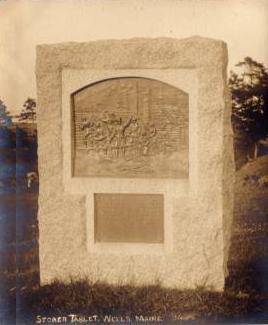Raid on Wells
| Raid on Wells (1692) | |||||||
|---|---|---|---|---|---|---|---|
| Part of King William's War | |||||||
 Storer Tablet, which marks the Storer garrison site |
|||||||
|
|||||||
| Belligerents | |||||||
|
Abenaki Mi'kmaq militia |
|
||||||
| Commanders and leaders | |||||||
| Sr. de la Broquerie (La Brognerie. Labocree) † Sr. de Portneuf Baron de St Castin Father Jean Baudoin |
Captain James Converse Joseph Storer |
||||||
| Strength | |||||||
| 400 Wabanaki Confederacy and Canadiens | 31 New England troops | ||||||
| Casualties and losses | |||||||
| unknown | unknown | ||||||
The Raid on Wells occurred during King William's War when French and Wabanaki Confederacy forces from New France attacked the English settlement at Wells, Maine, a frontier town on the coast below Acadia. The principal attack (1692) was led by La Brognerie, who was killed. Commander of the garrison, Captain James Converse, successfully repelled the raid despite being greatly outnumbered.
Wells was the resilient northeastern frontier of English settlement. Other early attempts to colonize Maine above Wells, including the Popham Colony in 1607, and Pejepscot (now Brunswick) in 1628, were abandoned except for a few forts and garrisons. Beginning with King Philip's War in 1675, Native American attacks destroyed many incipient towns. New France resented encroachment by New England in territory it considered its own, and used the Abenaki inhabitants to impede English settlement.
During King William's War, when Wells contained about 80 houses and log cabins strung along the Post Road, the town was attacked on June 9, 1691 by about 200 Native Americans commanded by the sachem Moxus. But Captain James Converse and his militia successfully defended Lieutenant Joseph Storer's garrison, which was surrounded by a gated palisade. Another sachem, Madockawando, threatened to return the next year "and have the dog Converse out of his den".
As the natives withdrew, they went to York off Cape Neddick and boarded a vessel and killed most of the crew. They also burned a hamlet.
A year passed when cattle, frightened and some wounded, suddenly ran into the town from their pastures. It was a recognized sign that a Native American attack was imminent, so residents sought refuge. On June 10, 1692, a force of 400 Native Americans and some French troops commanded by La Brognerie marched into Wells, knowing that Converse would be in Storer's garrison. But with a 15 soldier militia and an approximate number of townsfolk, Converse resisted assaults during a 2–3 day siege. The attackers alternated between attacks on the village and the narrow harbor, where Captain Samuel Storer, James Gooch and 14 soldiers, sent as reinforcements, were aboard two sloops and a shallop. Native Americans shot flaming arrows onto the boats, but the crews extinguished the fires. The attackers fastened a wall of vertical planks to the back of a cart, then pushed it toward the vessels at low tide. La Brognerie and 26 French and Native Americans huddled behind the shield, but the cart got stuck in mudflats within 50 feet of the nearest boat. When La Brognerie struggled to lift the wheel, he was shot through the head. The remainder ran, some dropping in the hail of bullets. Next they towed downstream a raft of about 18–20 feet square and covered with combustible material, expecting the ebbing tide to carry it ablaze to the boats. But the wind shifted and the raft drifted to the opposite shore.
...
Wikipedia
